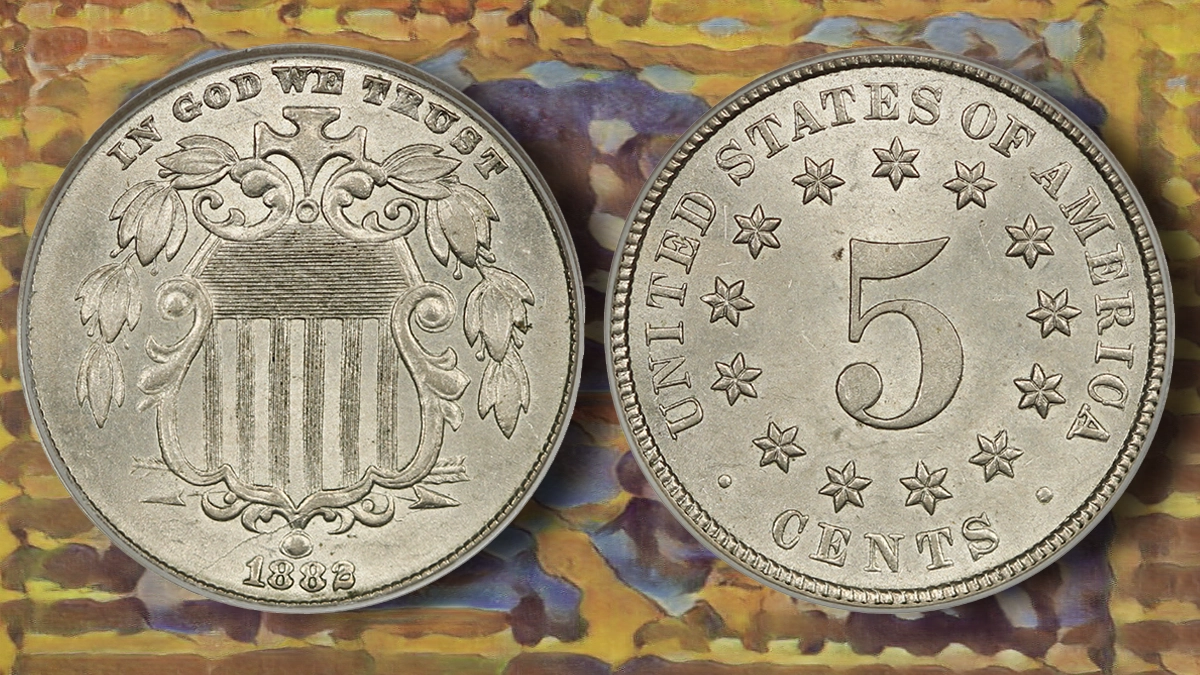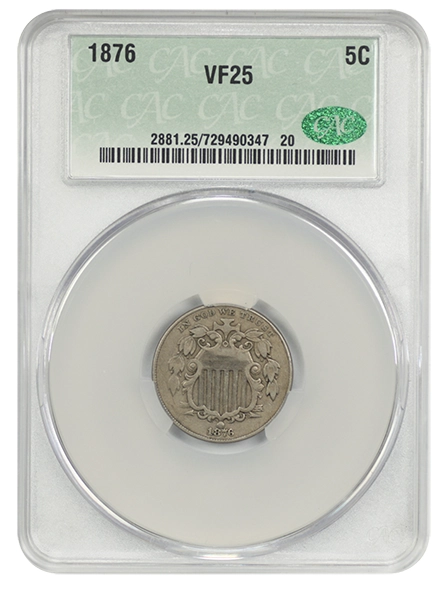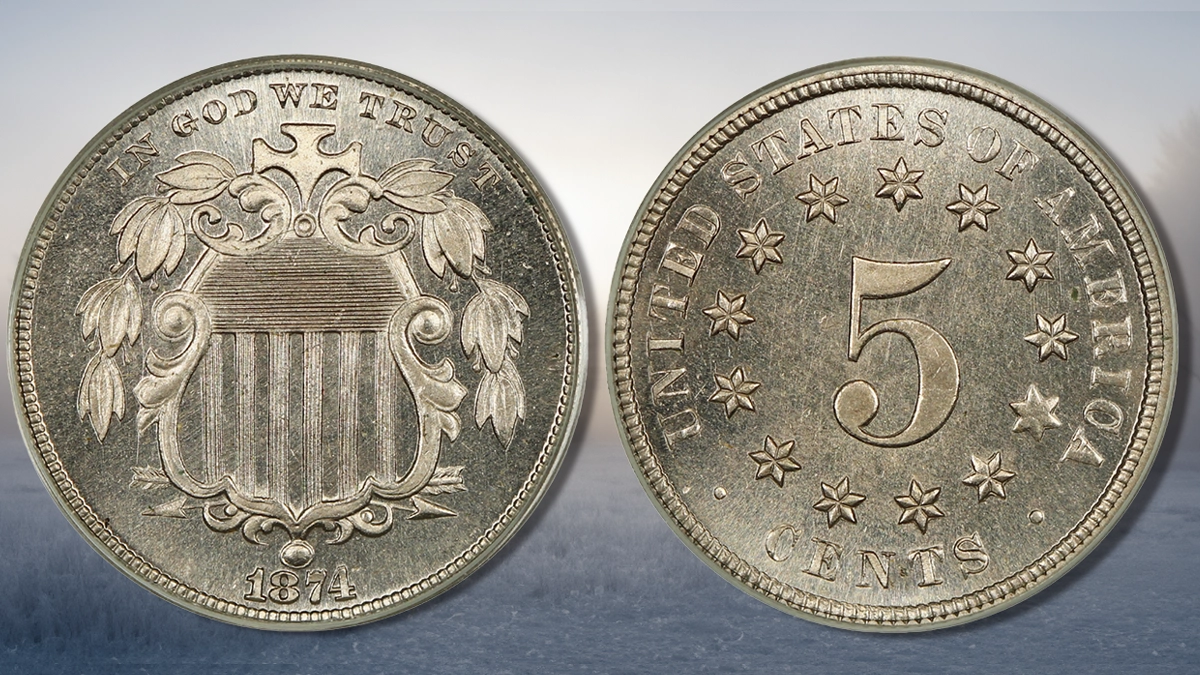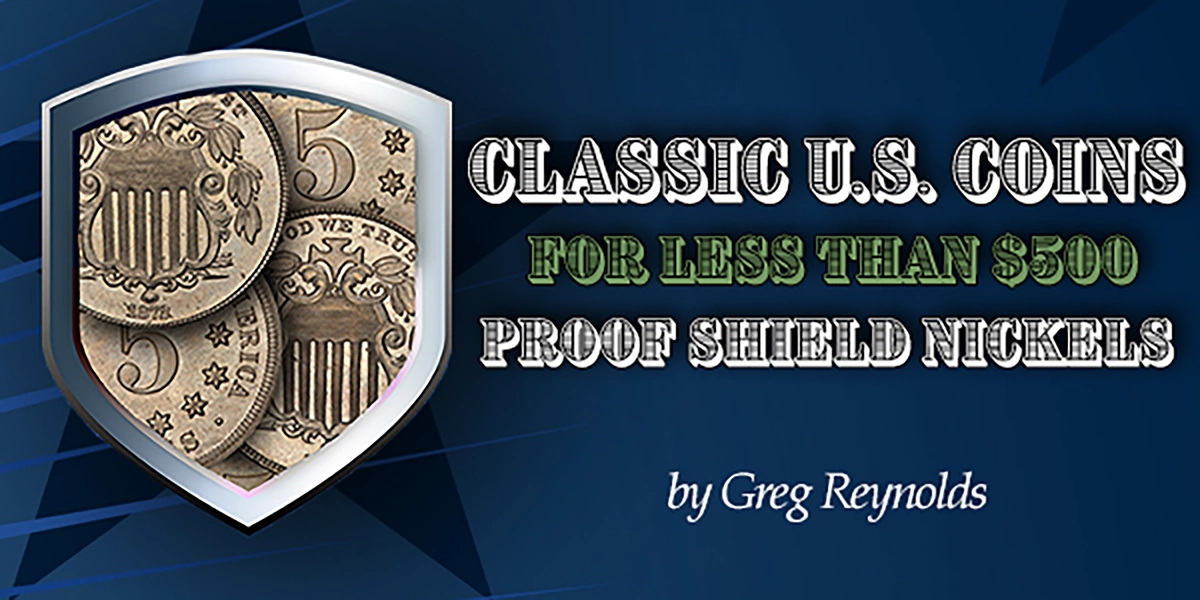
By Charles Morgan and Hubert Walker for CoinWeek Notes …..
With the exception of just one year (1871), production of the nickel five-cent piece was higher than that of the equivalently valued silver half dime each year through the end of the half dime’s production in 1873. The large base metal coin was clearly primed to replace the tiny silver piece.
The Shield Nickel wasn’t without its faults, however. Ongoing striking problems on the hard nickel blanks led to premature die failure, and pushed the United States Mint to make a modest design change of the Shield Nickel in early 1867.
Gone on the new revision were the reverse rays. With their removal, the Mint hoped that the coins would strike up more completely and that dies would last longer. There is agreement that the change produced the desired result, particularly in the sense of increasing die life so that more coins could be produced per die pair.
The design change resulted in 1867-dated Shield Nickels both With Rays and Without Rays. Elimination of the rays simplified the overall Shield Nickel design and gave the reverse side of the small coin an almost medallic appearance.

Collecting Shield Nickels
Business strike Shield Nickels with no rays are generally affordable up through middle Mint State grades, with strong increases at the Gem level and above.
Sharply struck coins remain a challenge but in general strike is considered to be better than that of the 1866-1867 With Rays coins.
No business strikes were produced in 1877 and 1878, attributed to lack of need due to the return of other small denomination, previously hoarded coins to circulation. Low-mintage 1879 through 1881 years are key, with 1880 the most scarce.
Cameo and Deep Cameo Proofs are listed in population/census reports, showing modest to significant price premiums over regular Proofs. Some Deep Cameo coins list at up to twice the price of Cameo coins.

Proofs from 1877 and 1878 are considered key, with the 1877 at roughly twice the price of the 1878, and together at four to 10 times the prices for the other years up to Gem level; where the price difference moderates to about twice the premium. The Proof only 1879/8 overdate is a significant variety, estimated to comprise as much as a third of the 1879 Proof mintage, but generally does not carry a significantly higher price. Counterfeits for the years 1870 through 1876 are common, circulating mostly in New York and New Jersey, but are easily identified because of different shield and letter designs.
Varieties
The Shield Nickel Without Rays has been studied extensively, with significant numbers of repunched dates, multiple die punch, and other die varieties known. The 1873 Open 3 and Closed 3, Proof 1879/8, and 1883/2 are probably the best known varieties. Some varieties have small premiums over regular issues, slightly more so with the Closed 3 1873 at higher Mint State grades. An 1883/2 overpunch has significantly higher premiums, often 10 times or more, at all grade levels.
Additional Shield Nickel Coverage from CoinWeek

Coin expert Greg Reynolds provides collectors insights into the Proof Shield Nickel issues and details several features that you need to be aware of when building your collection.
Design
Obverse:
The Shield Nickel has denticles along the rim of both sides. Since all were struck by the Philadelphia Mint, none display a mintmark. The obverse has the motto “In God We Trust” along the top periphery of the field, with the date centered at the bottom. In the center is an ornamented shield replete with azure, topped with a symbolic cross (often described as the cross of the Order of Calatrava, an old military/religious order in Spain, though this attribution is subject to debate), flanked on both sides by laurel leaves and lying above and in front of two crossed arrows at the bottom.
Reverse:
The reverse has the words “United States of America” around little more than the top half of the periphery, with the word “Cents” at the bottom edge. Two dots, one on each side, are equally spaced between the two text legends. A large numeral 5 is in the center, from which 13 six-point stars form an encircling wreath between the 5 and the text along the rim. The number 3 in 1873 coins was initially somewhat closed at the open end, causing confusion as to whether it was indeed a 3 or instead an 8. A change was made, resulting in both Open 3 and Closed 3 types for the year, but with Proofs only in the Closed style.
Edge:
The edge of the Shield Nickel Without Rays is plain or smooth, without reeding or edge lettering.
Coin Specifications
| Shield Nickels, No Rays | |
| Years Of Issue: | 1867-83 |
| Mintage (Circulation): | High: 28,890,500 (1867); Low: 16,000 (1880; none minted in 1877 and 1888) |
| Mintage (Proof): | High: 5,419 (1883); Low: 510 (1877) |
| Alloy: | 75% nickel, 25% copper |
| Weight: | 5.0 g |
| Diameter: | 20.5 mm |
| Edge: | Plain |
| OBV Designer: | James Barton Longacre |
| REV Designer: | James Barton Longacre |
* * *
References
Bowers, Q. David. The Experts Guide to Collecting & Investing in Rare Coins. Whitman Publishing.
–. A Guide Book of Shield and Liberty Head Nickels. Whitman Publishing.
–. A Guide Book of United States Type Coins. Whitman Publishing.
Breen, Walter. Walter Breen’s Complete Encyclopedia of United States Coins. Doubleday.
Taxay, Don. The U.S. Mint and Coinage. Arco Publishing.
Yeoman, R.S and Jeff Garrett (editor). The Official Red Book: A Guide Book of United States Coins. Whitman Publishing.
* * *





I have an 1888 nickel that looks like this one, it’s not in the best of shape. how much would you think it would be worth?
An 1888 nickle would be a liberty/V nickel, not a shield nickel.
I think it is odd that the difference between Ray and No Ray coins are discussed without a photo of either one. I found the information helpful, yet confusing because I still have to do an online search to find photos of each coin which means leaving your site.
Hello – I have a Shield Nickel with no Rays on it. Date is missing and coin in relatively poor condition, but I’m wondering whether it has value since on the shield side of the coin there is the number 4 plus letters C A P stamped on it. Any response would be appreciated. Thank you.